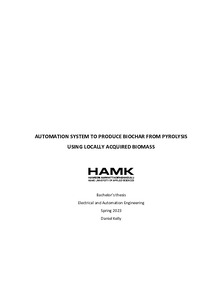Automation system to produce biochar from pyrolysis using locally acquired biomass
Kelly, Daniel (2023)
Kelly, Daniel
2023
All rights reserved. This publication is copyrighted. You may download, display and print it for Your own personal use. Commercial use is prohibited.
Julkaisun pysyvä osoite on
https://urn.fi/URN:NBN:fi:amk-2023053116477
https://urn.fi/URN:NBN:fi:amk-2023053116477
Tiivistelmä
The author of the thesis has had an interest in programmable logic controller systems since the day he entered this university, hence it was likely that the thesis topic would be about something that involves the use of such a system. Still, the exact topic was unclear and the commissioning party HAMK Tech made the topic selection process possible during a meeting.
The purpose of this thesis was to make the production of biochar continuous and to produce biochar of a consistent quality that meets the criteria for chemical and physical properties. This aim has been met since the product contained roughly 83% carbon on average by mass percent and other elements such as hydrogen (2.5%) and nitrogen (0.1%) which indicates that it is considered biochar.
Biochar was covered extensively in chapter two with the history of biochar, its definitions, and its effects, and ends with the history of pyrolysis. In subsequent chapters, the automation system is defined and explored in terms of its usefulness for this scenario, the control system architecture and the relevant algorithms were also discussed as well as justified. At the latter part of the thesis, the implementation will be discussed, and the results will be presented and analyzed.
The aim of this commissioned thesis work has been realized since the creation and use of an automated system for the pyrolysis of locally obtained biomass to produce biochar has proved successful. By lowering the amount of human labor required, decreasing the chance of mistakes, and making the best use of available resources, the automated system has fulfilled its intended purpose to increase the efficiency and efficacy of the biochar manufacturing process.
The purpose of this thesis was to make the production of biochar continuous and to produce biochar of a consistent quality that meets the criteria for chemical and physical properties. This aim has been met since the product contained roughly 83% carbon on average by mass percent and other elements such as hydrogen (2.5%) and nitrogen (0.1%) which indicates that it is considered biochar.
Biochar was covered extensively in chapter two with the history of biochar, its definitions, and its effects, and ends with the history of pyrolysis. In subsequent chapters, the automation system is defined and explored in terms of its usefulness for this scenario, the control system architecture and the relevant algorithms were also discussed as well as justified. At the latter part of the thesis, the implementation will be discussed, and the results will be presented and analyzed.
The aim of this commissioned thesis work has been realized since the creation and use of an automated system for the pyrolysis of locally obtained biomass to produce biochar has proved successful. By lowering the amount of human labor required, decreasing the chance of mistakes, and making the best use of available resources, the automated system has fulfilled its intended purpose to increase the efficiency and efficacy of the biochar manufacturing process.
